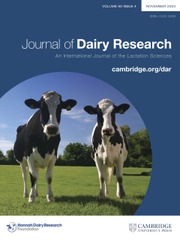Crossref Citations
This article has been cited by the following publications. This list is generated based on data provided by
Crossref.
Fabianová, Jana
Ducková, Viera
Čanigová, Margita
and
Kročko, Miroslav
2010.
Presence of enterococci in cow milk and their antibiotic resistance.
Potravinarstvo Slovak Journal of Food Sciences,
Vol. 4,
Issue. 2,
p.
17.
Fratianni, Alessandra
Criscio, Tiziana Di
Mignogna, Rossella
and
Panfili, Gianfranco
2012.
Carotenoids, tocols and retinols evolution during egg pasta – making processes.
Food Chemistry,
Vol. 131,
Issue. 2,
p.
590.
Čanigová, Margita
Ducková, Viera
Kročko, Miroslav
Račková, Jana
and
Bezeková, Jana
2012.
Enterococci and their ability to form a biofilm.
Potravinarstvo Slovak Journal of Food Sciences,
Vol. 6,
Issue. 2,
p.
15.
Manzi, Pamela
Di Costanzo, Maria
and
Mattera, Maria
2013.
Updating Nutritional Data and Evaluation of Technological Parameters of Italian Milk.
Foods,
Vol. 2,
Issue. 2,
p.
254.
Fratianni, Alessandra
Albanese, Donatella
Mignogna, Rossella
Cinquanta, Luciano
Panfili, Gianfranco
and
Di Matteo, Marisa
2013.
Degradation of Carotenoids in Apricot (Prunus armeniaca L.) During Drying Process.
Plant Foods for Human Nutrition,
Vol. 68,
Issue. 3,
p.
241.
Tremonte, Patrizio
Tipaldi, Luca
Succi, Mariantonietta
Pannella, Gianfranco
Falasca, Luisa
Capilongo, Valeria
Coppola, Raffaele
and
Sorrentino, Elena
2014.
Raw milk from vending machines: Effects of boiling, microwave treatment, and refrigeration on microbiological quality.
Journal of Dairy Science,
Vol. 97,
Issue. 6,
p.
3314.
Niro, Serena
Fratianni, Alessandra
Tremonte, Patrizio
Sorrentino, Elena
Tipaldi, Luca
Panfili, Gianfranco
and
Coppola, Raffaele
2014.
Innovative Caciocavallo cheeses made from a mixture of cow milk with ewe or goat milk.
Journal of Dairy Science,
Vol. 97,
Issue. 3,
p.
1296.
Kurzer, A.B.
Dunn, M.L.
Pike, O.A.
Eggett, D.L.
and
Jefferies, L.K.
2014.
Antioxidant effects on retinyl palmitate stability and isomerization in nonfat dry milk during thermally accelerated storage.
International Dairy Journal,
Vol. 35,
Issue. 2,
p.
111.
Fratianni, Alessandra
Panfili, Gianfranco
and
Cubadda, Raimondo
2015.
Processing and Impact on Active Components in Food.
p.
309.
Niro, Serena
Succi, Mariantonietta
Tremonte, Patrizio
Sorrentino, Elena
Coppola, Raffaele
Panfili, Gianfranco
and
Fratianni, Alessandra
2017.
Evolution of free amino acids during ripening of Caciocavallo cheeses made with different milks.
Journal of Dairy Science,
Vol. 100,
Issue. 12,
p.
9521.
Pannella, Gianfranco
Messia, Maria Cristina
Tremonte, Patrizio
Tipaldi, Luca
La Gatta, Barbara
Lombardi, Silvia Jane
Succi, Mariantonietta
Marconi, Emanuele
Coppola, Raffaele
and
Sorrentino, Elena
2019.
Concerns and solutions for raw milk from vending machines.
Journal of Food Processing and Preservation,
Vol. 43,
Issue. 10,
Niro, Serena
Fratianni, Alessandra
Tremonte, Patrizio
Lombardi, Silvia Jane
Sorrentino, Elena
Manzi, Pamela
and
Panfili, Gianfranco
2022.
Cis-trans retinol isomerisation: Influence of microorganisms during the production of pasta filata cheeses.
International Dairy Journal,
Vol. 133,
Issue. ,
p.
105441.
Paggio, Federico
Ritota, Mena
Di Costanzo, Maria Gabriella
Barzaghi, Stefania
Monti, Lucia
Ulrici, Alessandro
and
Manzi, Pamela
2023.
Effects of time and temperature of storage on chemical and nutritional characteristics of raw milk for Provolone Valpadana PDO cheesemaking: a multivariate approach.
Journal of Dairy Research,
Vol. 90,
Issue. 2,
p.
191.
Hardy, Dallin M.
Pike, Oscar A.
Taylor, Bradley J.
and
Dunn, Michael L.
2023.
Effect of process parameters on vitamins and sensory acceptability in micronutrient‐fortified soymilk prepared by small‐scale batch processing.
Food Science & Nutrition,
Vol. 11,
Issue. 3,
p.
1272.
Tian, Pengjiao
Hu, Huiying
Zhang, Xiya
Chen, Mingqing
and
Wang, Xiqing
2023.
Effects of Temperature and Moisture Levels on Vitamin A in Total Mixed Ration Silage.
Fermentation,
Vol. 9,
Issue. 7,
p.
614.


